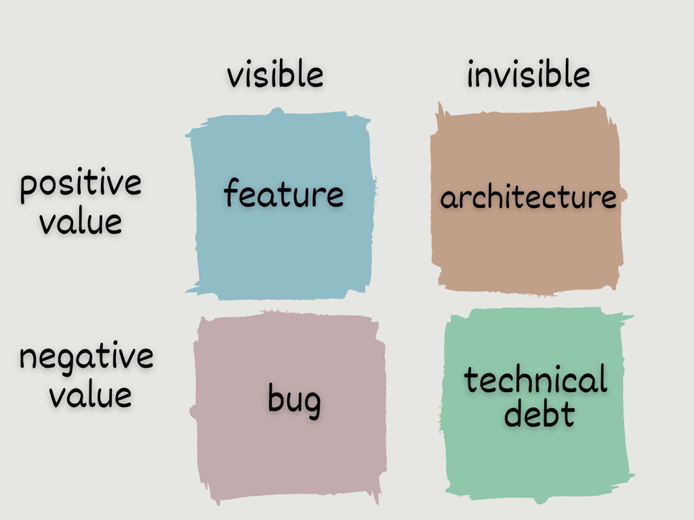Technical and design debt! What is it, and should you avoid it? The simple answer is YES!
Technical Debt
Technical debt is a metaphor used in software development to describe the consequences of prioritizing speed over code quality. Developers who make conscious or unmindful decisions to take shortcuts or use less-than-ideal solutions to address immediate problems rather than invest time and resources in developing a more robust and maintainable codebase.
Some examples of technical debt include using deprecated libraries or frameworks, neglecting code refactoring, ignoring code review and testing, and failing to address architectural issues. Managing technical debt often involves refactoring or rewriting the code to improve its structure, readability, and maintainability.
These shortcuts may work in the short term but can create issues and challenges eventually. Technical debt can accumulate over time, creating a codebase that is difficult to maintain, modify, and extend. As a result, technical debt can slow down future development, increase costs, and create user problems.
Design Debt
Design debt refers to the accumulation of design-related issues or problems that arise when a product or service is developed quickly without carefully considering the design. It is similar to technical debt, which refers to the accumulation of issues or problems that arise when code is rapidly developed without proper planning or testing.
Design debt can manifest in various ways, such as poor usability, confusing or inconsistent user interface, or a lack of attention to accessibility. These issues can lead to user frustration, reduced engagement, and increased support costs.
Design debt can be costly; like technical debt, it can accumulate over time if addressed. The best way to avoid design debt is to prioritize design considerations from the start of the development process and to continually evaluate and improve the design as the product or service evolves.
Design debt can be managed like technical debt, but it requires a conscious effort to balance short-term needs with long-term goals. Proper planning, design, and development practices can minimize the accumulation of design debt and avoid the consequences of poor-quality code.

Although Salesforce is a powerful customer relationship management (CRM) platform, as with any software system, Salesforce instances can accumulate technical debt over time. As discussed earlier, technical debt is the cost of maintaining and upgrading a system due to poor design or architecture decisions. In the case of Salesforce, technical debt can take many forms, such as custom code that is difficult to maintain, using an older API version that will soon be deprecated by Salesforce, or a cluttered data model that makes it hard to extract meaningful insights from the data and makes reporting challenging.
Causes of Technical Debt
One of the leading causes of Salesforce technical debt is custom code. Organizations often use custom code to add new functionality or work around the platform’s limitations. However, custom code can quickly become challenging to maintain and upgrade, especially as the Salesforce platform evolves, new releases are available, and older versions of the API are deprecated. Additionally, custom code can introduce security vulnerabilities and make it more difficult to troubleshoot issues. Salesforce now has a powerful workflow and automation tool with Flows, which often eliminates the need for writing any code and ensures your automation is upgraded to be safe for future versions of Salesforce.
Another common cause of Salesforce technical debt is a cluttered data model. As an organization uses Salesforce, it is easy for the data model to become confused with unnecessary fields, objects, and relationships. This can make reporting within Salesforce harder than it needs to be. It also means that extracting meaningful insights from the data becomes challenging, making it harder to maintain the data model over time.
A third form of technical debt related to Salesforce is its integration with other applications. If the integration is not designed to be scalable and maintainable, it becomes a long-term maintenance issue. Poorly designed integrations can cause data inconsistencies and errors, making it difficult to maintain and defeat the benefits of the integrated systems.
Strategy for Avoiding Technical Debt
To avoid Salesforce technical debt, it is essential to approach the platform with a clear strategy and make decisions that align with that strategy. Here are a few best practices for avoiding Salesforce technical debt:
- Limit the use of custom code: Only use it when necessary and ensure to document and test it properly.
- Keep the data model clean: Regularly review the data model to identify and remove unnecessary fields, objects, and relationships.
- Follow best practices: Salesforce provides a wealth of best practices and guidelines for configuring and customizing the platform. Follow these best practices to ensure your organization uses the most efficient and effective methods for working with the platform.
- Regularly review your instance: You should check your Salesforce instance to identify and fix any issues accumulated over time.
- Consider using the Salesforce managed package: Salesforce AppExchange offers a range of managed packages that are developed and maintained by Salesforce-vetted partners, which can help in reducing technical debt by implementing best practices, standardizing the implementation, and providing regular updates. However, verifying the application properly in a sandbox environment and monitoring how often it is updated is also essential. We often experience 3rd party AppExchange applications not being maintained and updated by the application developers, eventually resulting in deprecated API versions being used, which causes future maintenance issues and further increases your technical debt.
- Enforce governance and access control: Implementing a vital governance process, including access controls and change management, can help prevent unauthorized customizations, data quality issues, and accidental deletion of data.
By following these best practices and maintaining a clean and well-designed Salesforce instance, organizations can minimize the cost of maintaining and upgrading the system and ensure they get the most value out of the platform.
Let XTIVIA help you avoid technical or design debt with our certified Salesforce experts; we provide Salesforce consulting services – contact us today!

